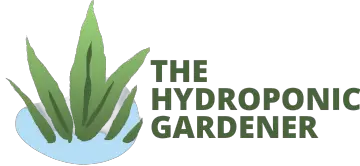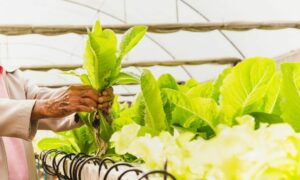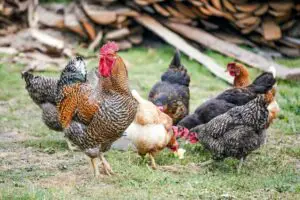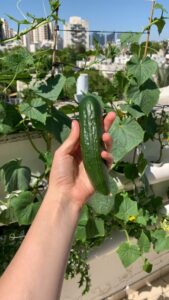Are you tired of waiting for the perfect weather or battling limited gardening space? If so, then it’s time to explore the captivating world of low-maintenance hydroponic systems. With these innovative systems, you can grow herbs, a bounty of fresh greens, and nutritious vegetables year-round without having a traditional soil outdoor garden.
Say goodbye to the constraints of soil and climate, and say hello to a new era of hassle-free gardening. Get ready to embark on an exciting journey where you become the master of your flourishing oasis, enjoying the abundance of nature’s goodness in the comfort of your home.
How Hydroponic Systems Work
These systems are marvels of modern gardening that revolutionize how we cultivate plants. Instead of relying on traditional soil-based methods, hydroponics harness the power of water and nutrients to create an optimized environment for plant growth. But how exactly do these systems work their magic?
The core of hydroponics is providing plants with the essential elements they need to thrive: water, nutrients, and oxygen. By carefully controlling and delivering these elements directly to the plant roots, hydroponic systems maximize a plant’s nutrient uptake and promote accelerated growth.
In a hydroponic setup, crops are typically grown in a soil-less medium such as perlite, vermiculite, coconut coir, or Rockwool. These mediums provide support for the roots while allowing for efficient nutrient absorption and oxygenation. The plants’ roots are suspended or supported in the medium, ensuring they have direct access to the water and nutrient solution.
Another vital component of hydroponic systems is the nutrient solution. It consists of a carefully balanced mixture of water and essential nutrients that plants need for their development. These nutrients are dissolved in the water and delivered directly to the plant roots in a highly accessible form. By eliminating the need for crops to search for nutrients in the soil, these systems enable faster growth and higher yields.
To ensure optimal oxygen levels these systems employ various techniques such as air pumps, oxygen diffusers, or aeroponic techniques. These methods introduce oxygen into the root zone, preventing root rot and promoting vigorous plant growth.
Intriguingly, hydroponic systems also offer greater control over environmental factors like temperature, humidity, and lighting. By fine-tuning these variables, gardeners can create an ideal growth environment that maximizes plant health and productivity.
My personal favorite
This machine is my personal favorite for small spaces. It by Duesi, it’s silent and low maintenance and easy to use. This image here is from my friend’s house. She doesn’t have green fingers but lo and behold – her tomato plant is large and healthy.
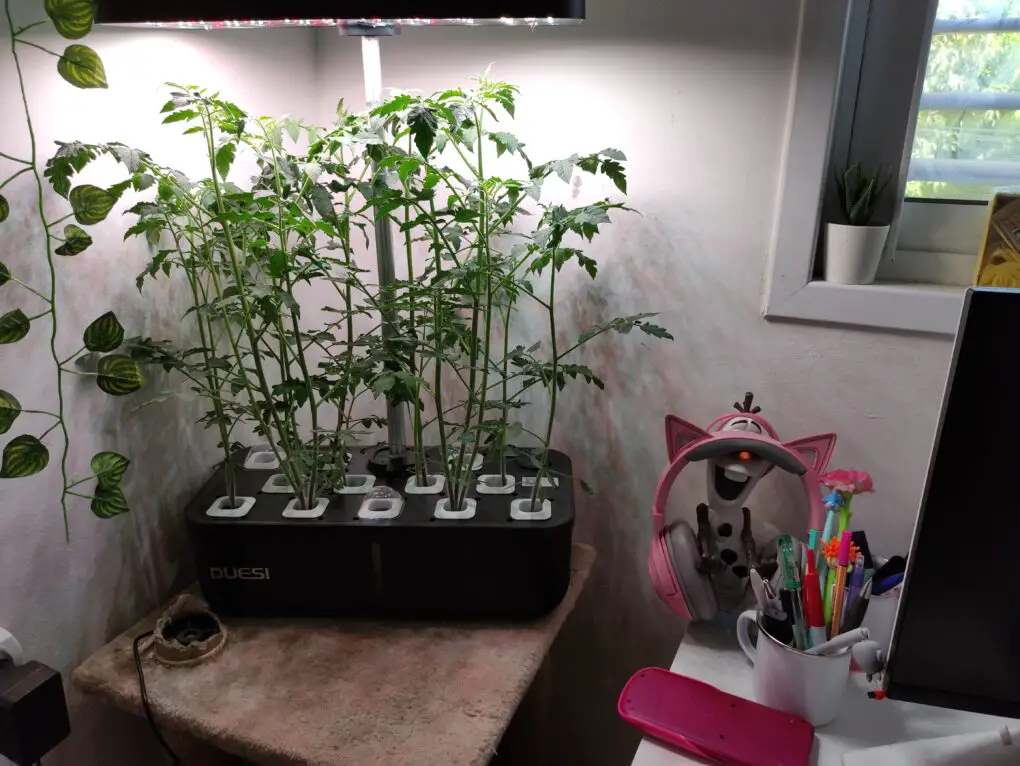
Types of Water-Based Gardening Systems
The primary elements of water-based gardening systems are Deep Water Culture (DWC), Ebb and Flow (Flood and Drain), and Nutrient Film Technique (NFT). These elements form the foundation of hydroponic systems, allowing plants to thrive without the use of soil. Each method offers unique advantages and techniques for growing plants in a water-based environment. Let’s explore these primary elements and their contributions to the world of hydroponics.
Deep Water Culture (DWC) System
In a DWC system, plants are suspended in a nutrient-rich water solution, with their roots directly immersed in the water. Oxygen is supplied to the roots through the use of air stones or diffusers, creating an oxygen-rich environment. DWC systems are known for their simplicity and effectiveness, making them popular among beginners and home growers.
Ebb and Flow System (Flood and Drain)
The Ebb and Flow system works by periodically flooding the plant’s growing tray with the nutrient solution and then draining it back into the reservoir. This cyclic process ensures that the roots receive water and nutrients while allowing for proper aeration during the draining phase. Ebb and Flow systems are versatile and suitable for larger plants or those with longer growth cycles.
Nutrient Film Technique (N.F.T)
NFT involves a thin film of nutrient solution continuously flowing over the bare plant roots of the plants, creating a shallow stream. This technique ensures a constant supply of water and nutrients while allowing the excess solution to be collected and recirculated. NFT systems are highly efficient, use minimal water and nutrients, and are ideal for growing smaller plants and herbs.

What to Consider When Choosing a Low-Maintenance Hydroponic System
You must consider several important factors when selecting the best hydroponic system for your needs. From the types of plants you want to grow to the available space and budget, each aspect is crucial in determining the most suitable system for you. Let’s explore these factors in more detail.
Plant Types
Consider the specific plants you intend to grow. Some systems are better suited for leafy greens and herbs, while others accommodate larger vegetables or fruiting plants. Understanding the requirements and growth habits of your desired plant types will help you choose a system that provides optimal conditions for their development.
Growing Conditions
Evaluate the environmental conditions in which you’ll grow your plants, including temperature, humidity, and available space. Some systems are more adaptable to varying conditions, while others require specific parameters to ensure successful growth. Ensure that the hydroponic system you choose can effectively accommodate and regulate these conditions.
Cost
Budget considerations play a significant role in choosing a hydroponic system. Different systems come with varying costs, including initial setup expenses and ongoing maintenance requirements. Evaluate the initial investment required for the equipment, as well as ongoing costs for water, nutrients, and electricity. Think about your budgetary constraints and choose a system that offers the right balance between affordability and performance.
Aesthetic Appeal
Consider its visual appeal if the hydroponic system is to be displayed in a visible area, such as an indoor garden, living room or office. Some systems are designed to be visually appealing, with sleek designs and modern aesthetics. If the appearance of your system matters to you, consider options that blend well with your indoor or outdoor space. Look for systems with sleek designs, clean lines, and modern aesthetics that will enhance the overall appearance of the space.
Space Efficiency
Assess the available space you have for the hydroponic system. Some systems are compact and suitable for small spaces, while others require more room for larger setups. Choose a system that maximizes space usage, whether it’s a compact vertical system or one that utilizes shelves or racks to grow plants vertically.
Nutrient Delivery
Evaluate the nutrient delivery method of the hydroponic system. Some systems use a recirculating nutrient solution, while others require manual feeding. Consider your preferences and the ease of nutrient management.
Maintenance
Consider the level of maintenance required for the hydroponic system. Some systems may require more frequent monitoring and adjustments, while others are designed for low-maintenance operation. Choose a system that aligns with your desired level of involvement.
Expansion Potential
If you plan to expand your hydroponic setup in the future, consider systems that can be easily scaled or modified to accommodate additional plants.

Maintenance of Hydroponic Systems
Proper maintenance is essential to keep your system operating at its best and ensure healthy plant growth. Here are some important maintenance practices to consider.
pH adjustment in hydroponic systems
Maintaining the proper pH level is crucial for optimal nutrient absorption and growth. The recommended pH range for most hydroponic crops is typically between 5.5 and 6.5.
Regular monitoring of the pH level is essential to ensure it stays within the desired range. You can use pH test kits or digital meters to accurately measure the pH of the nutrient solution. If the pH is too high (alkaline), you can lower it by adding pH-down solutions or acids. Conversely, if the pH is too low (acidic), you can raise it by adding pH-up solutions or bases.
It’s important to check the pH regularly, as factors such as nutrient uptake, water quality, and environmental conditions can influence pH levels. By maintaining the proper pH range, you provide an optimal environment for nutrient absorption, enzymatic activity, and overall plant health in your hydroponic system.
Testing the nutrient solution pH
Testing the pH of the nutrient solution is an essential task in hydroponic systems. By using pH test kits or digital meters, you can accurately measure the pH level of the solution. This allows you to monitor and ensure that the pH remains within the desired range.
Maintaining the proper pH range is crucial to prevent nutrient imbalances that can negatively impact plant health and growth. Different plants have specific pH preferences for optimal nutrient absorption. Typically, the recommended pH range for most hydroponic crops falls between 5.5 and 6.5. However, referring to specific plant requirements for precise pH guidelines is important.
Regularly testing the nutrient solution pH helps you identify any deviations from the desired range. If the pH is too high (alkaline), adjustments can be made by adding pH-down solutions or acids to lower the pH. Conversely, if the pH is too low (acidic), you can add pH-up solutions or bases to raise the pH level.
By testing the nutrient solution pH and ensuring it stays within the appropriate range, you create an optimal environment for nutrient uptake and absorption by the plants, promoting healthy growth and maximizing the potential of your system.

Aeration techniques
A crucial aspect of any hydroponic system is aeration, which involves providing oxygen to the plant’s roots submerged in the nutrient solution. Adequate oxygenation is essential for healthy root development and overall growth. Different aeration methods are used in hydroponics, each offering its own advantages. Let’s delve into three popular aeration techniques: passive aeration (Kratky method), drip systems, and active aeration.
Passive Aeration (Kratky Method)
The Kratky method is a passive aeration technique that requires no external air pumps or diffusers. In this method, the nutrient solution is initially filled to a level that submerges the roots of the plants. Over time, as the plants consume the oxygen in the solution, the water level decreases, creating an air gap between the solution and the roots. This air gap provides a passive source of oxygen to the plant roots. The Kratky method is simple, cost-effective, and suitable for small-scale setups, especially for beginners.
Active Aeration
Active aeration involves the use of air pumps or diffusers to introduce oxygen directly into the nutrient solution. The air pump pushes air through a diffuser or airstone placed in the nutrient solution, creating a bubbling effect. The bubbles increase the oxygen levels in the solution, benefiting the roots. Active aeration ensures a consistent and ample oxygen supply, which can enhance nutrient uptake and promote robust plant growth. This method is commonly used in larger hydroponic systems where a higher oxygen level is required.
Drip Systems
These systems utilize a controlled delivery of the nutrient solution to the roots. A water pump circulates the solution through a network of tubes or drippers, providing a steady drip or flow directly to the root zone of each plant. This delivery method ensures that the roots receive a constant supply of oxygen-rich solution, promoting vigorous growth. Drip systems are versatile, allowing precise control over nutrient delivery and are commonly used in larger hydroponic operations.
The choice of aeration technique depends on factors such as the size of the hydroponic system, plant species being cultivated, your budget, and desired oxygen levels. Passive aeration is suitable for smaller setups with low maintenance requirements, while drip systems offer controlled delivery of oxygen-rich solutions for larger-scale systems. Active aeration is recommended for those seeking precise control over oxygen levels and optimal nutrient uptake. By implementing the appropriate aeration techniques, you can ensure the plants receive the requisite oxygen, promoting healthy root system development and overall growth in your system.
Cleaning And Sanitizing The System
Keeping your hydroponic system clean and sanitized is crucial for maintaining healthy plants. Regularly clean and sanitize all system components, including reservoirs, grow trays, tubing, and pumps. By doing so, you prevent the growth of unwanted organisms such as algae, bacteria, and pathogens that can negatively impact your plants’ health and productivity.
When transitioning between plantings, it’s important to consider food safety guidelines. Practicing good hygiene and sanitation is essential to minimize the risk of contamination and the spread of diseases. Clean and disinfect all equipment, containers, and tools before introducing new plants. This helps eliminate potential pathogens or pests from the previous crop, creating a safe and optimal environment for your new plants to thrive.
By prioritizing cleaning and sanitizing procedures and following food safety considerations, you create a clean and disease-free environment for your hydroponic plants. This promotes their overall well-being and enhances the quality and safety of the produce you grow. Taking these precautions between plantings ensures that your hydroponic system remains healthy and provides a successful and sustainable gardening experience.
Food Safety Considerations Between Plantings
Food safety should be a top priority when transitioning between crops in your hydroponic system. Practicing good hygiene and sanitation is crucial to prevent the spread of diseases and ensure the safety of your plants and the food they produce. When moving from one crop to another, following proper protocols to maintain a clean and healthy growing environment is essential.
Start by practicing good hygiene yourself. Before working with your hydroponic system, make sure to wash your hands thoroughly with soap and water. This helps minimize the transfer of pathogens to the plants. Additionally, wearing clean gloves can provide an extra layer of protection.
Next, focus on cleaning and disinfecting all equipment, containers, and tools used in the system. This includes reservoirs, grow trays, net pots, and any other items that come into contact with the plants or nutrient solution. Use a mild detergent and warm water to clean the surfaces, removing all debris, residues, and organic matter. After cleaning, disinfect the equipment using a suitable sanitizing solution or approved disinfectant. Follow the manufacturer’s instructions for proper dilution and contact time to effectively kill any remaining pathogens.
Pay special attention to high-touch areas and equipment that may harbor bacteria or other contaminants. These can include fittings, tubing, pumps, and filters. Thoroughly clean and disinfect these components to prevent cross-contamination between crops.
By practicing good hygiene, thorough cleaning, and proper disinfection, you minimize the risk of introducing pathogens or contaminants that can negatively affect your crops. This ensures the safety of your plants and the food they produce, allowing you to enjoy fresh and healthy harvests from your system.
Refilling And Partial Change-Outs
Refilling and performing partial change-outs of the nutrient solution are essential tasks in maintaining a healthy hydroponic system. These practices help ensure a proper nutrient balance and prevent the accumulation of excess minerals that can harm your plants.
Regularly replenishing the nutrient solution is important to provide your plants with a continuous supply of essential nutrients. As plants absorb these nutrients, the concentration in the solution gradually decreases. Monitoring the nutrient levels and top-up, the solution as needed to maintain the desired nutrient balance is crucial. This helps promote healthy plant growth, optimal nutrient uptake, and overall plant health.
Performing partial change-outs of the nutrient solution is another vital practice to prevent the accumulation of excess minerals. Over time, minerals and salts can build up in the system, leading to nutrient imbalances and potential damage to your plants. By periodically replacing a portion of the nutrient solution with a fresh, well-balanced solution, you dilute the accumulated minerals and maintain a more stable nutrient composition.
When performing a partial change-out, carefully drain a portion of the existing nutrient solution from the reservoir and then replace it with a fresh batch that matches the desired nutrient strength and pH. The frequency of partial change-outs can vary depending on factors such as growth stage, water quality, and the specific needs of your hydroponic system. It is recommended to perform partial change-outs every 1-2 weeks or as necessary to maintain the desired nutrient balance.
By regularly replenishing the nutrient solution and performing partial change-outs, you ensure that your plants have access to a well-balanced and properly diluted nutrient solution. This helps promote healthy growth, prevents nutrient imbalances, and contributes to the overall success of your hydroponic system.
Do I Need To Clean My Hydroponic Garden System?
Maintaining cleanliness in your hydroponic garden system ensures optimal growth and prevents potential issues. Over time, algae, bacteria, and other microorganisms can accumulate in the system, negatively impacting plant health. Therefore, regular cleaning is necessary to remove these contaminants and promote a healthy growing environment.
Cleaning your hydroponic garden system involves several steps.
- Flushing the System- Periodically flush the system with clean water to remove any accumulated debris or sediment. This helps to prevent clogs and ensures proper nutrient flow.
- Cleaning the Components- Disassemble and clean all the components of your hydroponic system, including the reservoir, pipes, pumps, and grow trays. Use a mild cleaning solution and a soft brush or cloth to scrub away any residue or buildup. Rinse thoroughly to remove any cleaning solution residues.
- Sanitizing- After cleaning, it is important to sanitize the system to eliminate any remaining bacteria or pathogens. Use a sanitizing agent recommended for hydroponic systems and follow the instructions carefully. This step helps prevent the spread of diseases and ensures a clean growing environment.
- Regular Maintenance- Implement a regular maintenance schedule to clean and inspect your hydroponic system. This may include routine checks for leaks, proper functioning of pumps and timers, and regular replacement of filters or air stones if necessary.

Fresh Greens, Herbs, and Vegetables You Can Grow Hydroponically
Growing fresh greens, herbs, and vegetables hydroponically offers a fantastic opportunity to cultivate a wide variety of nutritious and flavorful crops all year round. With the right hydroponic setup, you can enjoy a continuous supply of fresh produce without the limitations of traditional soil-based gardening. Here are some popular options for hydroponic crops.
Leafy Greens- Lettuce, spinach, kale, arugula, and Swiss chard thrive in hydroponic systems. They have shallow root systems and grow quickly, making them ideal for vertical or compact setups.
Herbs– Basil, cilantro, parsley, mint, and thyme are well-suited for hydroponic cultivation. They offer vibrant flavors and aromas and can be easily grown in small spaces or on windowsills.
Tomatoes- Hydroponic systems provide excellent conditions for growing fresh tomatoes. Compact or dwarf varieties are often preferred, and you can enjoy a steady supply of fresh, juicy tomatoes throughout the year.
Cucumbers- English cucumbers or mini cucumbers are popular choices for hydroponic cultivation. They produce crisp and flavorful fruits and can be trained to grow vertically, saving space.
Peppers- Bell peppers, chili peppers, and other varieties thrive in hydroponic systems. They require warmth and can be grown year-round to add a spicy kick to your dishes.
Strawberries- Hydroponics allows for precise control of water and nutrient levels, creating optimal conditions for growing strawberries. Enjoy plump, juicy berries without the need for soil.
Microgreens- These nutrient-packed baby greens are harvested at an early stage. Microgreens like radish, broccoli, sunflower, and pea shoots are quick to grow and add a burst of flavor to salads and dishes.

Growing Plants Hydroponically Indoors
Indoor hydroponics is a fantastic way to cultivate a wide variety of plants without the need for traditional soil-based gardening. Hydroponic systems allow you to provide plants with the perfect balance of water, nutrients, and oxygen directly to their roots, promoting healthy growth and maximizing yields.
Growing plants inddors through hydroponic gardening offers several advantages. Firstly, you have complete control over the growing environment, including temperature, humidity, and lighting conditions. This allows you to create optimal conditions for your plants’ growth and customize the environment to suit different plant species.
Additionally, growing plants hydroponically indoors eliminates the need for soil, which reduces the risk of soil-borne pests and diseases. It also conserves water since hydroponic systems use water more efficiently than traditional gardening methods.
Depending on your space, budget, and plant types, you will need a suitable hydroponic system, such as deep water culture, nutrient film technique, or ebb and flow system. You will also need to provide adequate lighting, either through natural sunlight or artificial grow lights, and ensure proper nutrient supplementation to meet your plants’ specific needs.
With careful attention to the growing environment, nutrient management, and regular monitoring, you can successfully grow a wide range of plants hydroponically indoors, including leafy greens, herbs, vegetables, and even flowering plants. It’s a rewarding and sustainable way to enjoy fresh, homegrown produce year-round.
What Kind Of Lights Should You Use In An Indoor Hydroponic System?
Choosing the appropriate lighting for an indoor hydroponic system is crucial for providing plants with the necessary light energy for photosynthesis. When it comes to selecting lights, there are a few options to consider:
LED Grow Lights
Light Emitting Diode or LED grow lights have become increasingly popular for indoor gardening. They are energy-efficient, long-lasting, and provide a wide spectrum of light that can be tailored to different stages of growth. LED lights are available in various color spectrums, including full spectrum led grow light options, which mimic natural sunlight and promote optimal growth.
High-Intensity Discharge (HID) Lights
HID lights, such as High-Pressure Sodium (HPS) and Metal Halide (MH) bulbs, have been traditionally used in indoor gardening. HPS. lights emit a warm spectrum of light suitable for the flowering and fruiting stages, while MH lights produce a cool spectrum ideal for vegetative growth. HID lights are powerful and efficient but generate more heat and require adequate ventilation.
Fluorescent Lights
Fluorescent lights, particularly T5 and compact fluorescent bulbs, are a cost-effective option for small-scale hydroponic systems or for starting seedlings. They emit a balanced spectrum of light that promotes healthy growth in plants. Fluorescent lights are cooler than HID lights, making them suitable for keeping plants close to the light source without overheating.
Induction Lights
Induction lights are a relatively newer technology in indoor gardening. They offer a balanced spectrum of light and high energy efficiency, making them an attractive option. However, they tend to be more expensive upfront.
Can Low-Maintenance Hydroponic Systems Be Automated?
Yes, you can automate these hydroponic systems to a great extent. Automation in hydroponics can help simplify the growing process, increase efficiency, and reduce the time and effort required for maintenance. Here are some common automation techniques used in hydroponic systems:
- Timer-controlled irrigation – Automated timers can be set to control the frequency and duration of watering cycles, ensuring plants receive the right amount of water at the appropriate intervals.
- Nutrient delivery systems – Automated nutrient dosers or controllers can accurately measure and deliver the required nutrient solutions to the plants. These systems can monitor and adjust nutrient levels based on the needs of the plants.
- pH regulation – pH levels in hydroponic systems need to be carefully maintained within a specific range. pH controllers can automatically monitor the pH levels and adjust by adding acid or alkaline solutions.
- Temperature and humidity control – Environmental parameters like temperature and humidity play a crucial role in hydroponic systems. Automated systems can control and regulate these factors by using sensors, fans, heaters, or coolers.
- Lighting control – Depending on the type of plants being grown, automated lighting systems can be programmed to provide the optimal light spectrum, intensity, and duration for different growth stages.
- Monitoring and data logging – Sensors and monitors can be installed to continuously measure factors like temperature, humidity, pH, electrical conductivity, and nutrient levels. This data can be logged and analyzed to make informed decisions about system adjustments.
- Alarms and notifications – Automated systems can be equipped with alarms or notifications to alert growers of any deviations from desired parameters or potential issues, such as low nutrient levels or equipment malfunctions.
By incorporating these automation techniques, hydroponic systems can operate with minimal human intervention, allowing growers to focus on other aspects of plant cultivation, such as crop management and harvest.
Are Low-Maintenance Hydroponic Systems Suitable For Beginners?
Yes, low-maintenance hydroponic systems are often recommended for beginners and commercial growing as they are designed to be easy to set up and operate, requiring less time and effort compared to more complex hydroponic systems while still producing healthy and abundant crops.
Here are a few reasons why these systems can be beginner-friendly:
- Reduced watering frequency – Hydroponic systems use water-efficient techniques such as recirculating systems or drip irrigation, requiring less frequent watering than soil-based gardening. This can be beneficial for beginners who may not have experience with proper watering techniques.
- Controlled nutrient delivery – Low-maintenance hydroponic systems often incorporate automated nutrient delivery systems that provide the necessary nutrients to the plants in a balanced manner. This eliminates the need for beginners to manually mix and measure nutrient solutions, reducing the chances of errors.
- Elimination of soil-related issues – Soil-based gardening can come with challenges, such as soil-borne diseases, weeds, and inconsistent nutrient levels. Hydroponic systems eliminate these issues, providing a more controlled and sterile growing environment.
- Simplified pest control – Hydroponic systems can be designed with measures to prevent or minimize pest infestations. For example, using netting, screens, or physical barriers can help keep pests away from the plants. This can be advantageous for beginners who may not be experienced in dealing with pests.
- Educational resources and kits – Many resources are available online and in books that provide step-by-step instructions and guidance for setting up and maintaining low-maintenance hydroponic systems. Additionally, beginner-friendly hydroponic kits often come with detailed instructions and all the necessary components to get started.
While these systems can be beginner-friendly, it’s still important for beginners to educate themselves about the basics of hydroponics, including nutrient requirements, pH management, and system maintenance. By learning these fundamental concepts and starting with a low-maintenance system, beginners can gain hands-on experience and gradually expand their hydroponic knowledge and skills.
In conclusion, low-maintenance hydroponic systems offer an exciting and accessible opportunity for individuals to grow fresh greens, herbs, and vegetables throughout the year. They provide a controlled and efficient environment that simplifies the growing process and reduces the need for extensive maintenance. With automated features such as timer-controlled irrigation, nutrient delivery systems, and pH regulation, even beginners can successfully cultivate plants without the complexities associated with traditional soil-based gardening.
As technology advances, hydroponics automation will likely become more sophisticated and user-friendly, further enhancing the accessibility and ease of these systems. Whether you are a beginner or an experienced gardener, low-maintenance hydroponic systems provide a fascinating and rewarding way to grow fresh and nutritious food all year. Embrace the possibilities and embark on a sustainable and convenient indoor gardening journey with low-maintenance hydroponics.
